M25 DBFOWinner of a CEEQUAL Outstanding Achievement Award 2013 for Project Management Winner of a CEEQUAL Outstanding Achievement Award 2013 for Land Use Highly Commended CEEQUAL Outstanding Achievement Award 2013 for Material Use |
|
Whole Project with Interim award
Project Team
Client: Highways
Agency
Design: Atkins
Ramboll WSP
Construction: Connect
Plus/Skanksa Balfour
Beatty JV
The M25 DBFO Scheme comprised the upgrade of the M25 to a dual 4 lane controlled motorway standard. The project was divided into CEEQUAL multiple packages, the division being made between junctions. CEEQUAL was actively used to track environmental performance through each stage of the project and to identify areas where improvements could have been made. CEEQUAL provided a framework for ensuring that environmental considerations were included at design stage and implemented during the construction phase. External verification helped to provide assurance to the Highways Agency that high standards were being maintained.
M25 DBFO Section 1x Junctions 16 to 18 (CQA170A)
Whole Project Award – Excellent (87%)
Section 1x comprises the stretch of motorway between Junctions 16 and 18. No areas designated for ecological or landscape value were affected directly by the project, although new structures for reptiles, invertebrates, birds and bats are to be installed as part of the completed project.

Photo: Bird box installation
Specific measures have been included in the design to
reduce pollution impacts to the River Alderbourne at Junction 16.
The Chalfont Viaduct is the only feature of heritage interest within
Section 1x identified in advance of the works. The viaduct’s piers
were protected during construction. A watching brief was maintained
during construction to identify any below-ground archaeological remains
that might exist.
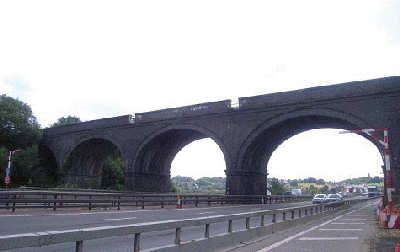
Photo: Chalfont Viaduct between J16 and J17
M25 DBFO Section 1y (Junctions 18 to 21a) (CQA170B)
Whole Project Award – Excellent (87.2%)
The project materials strategy focussed on the use of recycled and secondary materials in preference to primary aggregates. Inert demolition waste from other projects in the south east was processed on site to produce recycled aggregate along with waste glass from domestic recycling; in total 92% of aggregate was from non-primary sources.
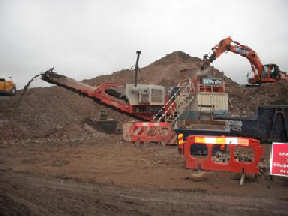
Photo: Material recycling at site compound
An innovative King Sheet Pile design reduced the amount of steel required by 30%. With this and the use of 100% recycled steel, the team reduced the carbon footprint of this activity by 55,000 tonnes CO2 equivalent across the project.
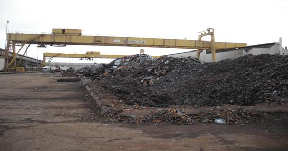
Photo: Recycled steel used to produce 100%
recycled steel sheet piles used on the project
M25 DBFO Section 1z (Junctions 21a to 23) (CQA170C)
Whole Project Award – Excellent (92.5%)
Approximately 90% of the 7km section between Junctions 21a and 22 interfaced with 6 historic landfill sites, some of which extend directly beneath the motorway. Extensive monitoring and geotechnical investigation was undertaken prior to construction. This led to the development of an award winning materials strategy to control the movement of contaminated materials, while maximising re-use of suitable material and avoiding pollution to the environment.

Figure: J21a to J22 of M25 the green areas show landfill sites interacting
with the motorway
Due to the presence of landfill beneath the motorway, underground attenuation was designed out in favour of a number of ponds. These sustainable drainage systems allowed for attenuation and treatment of run-off prior to discharging to the environment, while also providing additional soft estate and wildlife habitat.

Photo: Newly constructed pond at J22
5km of the verge through this section provided habitat to protected species, a capture programme saw 200 newts and reptiles moved from the project. In addition to this mitigation, two otter holts were constructed and two sections of water course were enhanced.
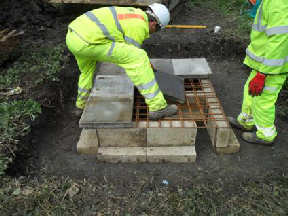
Photo: Construction of otter holt using recycled materials
A life cycle energy and carbon report was produced at the design stage. This analysed the key materials and components used throughout the project, showing savings made between tender design and detailed design. Changes to lighting were also made at the construction stage, enabling lights to be turned off on the mainline of the motorway, but remain switched on at junctions. This allows potential energy and carbon savings in the future operational life of the motorway.
M25 DBFO Section 4a Junctions 27 to 30 (CQA170D)
Whole Project Award – Excellent (79.5%)
Section 4a covers an 8.5 km section of motorway from Junction 27 towards Junction 28. The design aimed to mitigate the environmental impacts and provide enhancements. In particular:
A large programme of ecological protected species work has been undertaken, including the provision of artificial hibernacula and log piles for Great Crested Newts, reptiles and invertebrates, the management of retained scrub for reptiles and the erection of bird and bat boxes.- Provision of the River Roding flood compensation scheme, which allows for climate change adaptation.
- A programme of archaeological evaluation, devised in close consultation with Essex County Council.
- An extensive landscaping scheme, providing visual amenity and ecological
benefits.

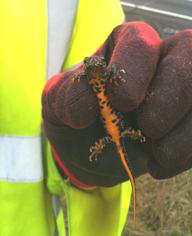
A grass snake (left) and great crested newt (right) caught during
the reptile and amphibian
translocation in Section 4a. Over 700 animals were moved from the construction
footprint.

A completed section of the project
M25 DBFO Section 4b (Junctions 28 to 29) (CQA170E)
Whole Project Award – Excellent (83.7%)
The project passes through the Essex countryside and involved the widening of the carriageway from before Junction 28 up to Junction 29. The materials strategy for the project focussed on retaining all excavated material on-site and obtaining all imported aggregates from secondary or recycled sources. This included the use of PFA, IBAA, glass sand and site won recycled crushed concrete. In total 92% of aggregate was from non-primary sources.

Use of recycled glass sand as backfill to smooth faced retaining
walls
The drainage strategy for the project included a series of four attenuation ponds rather than the large diameter drainage attenuation pipes originally proposed for the scheme. This approach reduced pipe sizes and associated earthworks by 90% as well as improving ease of maintenance. The ponds had the additional benefit of providing enhanced habitat with both tussocky and species rich grassland provided at each location.
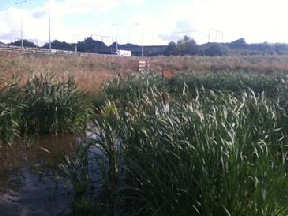
Newly established pond in 4b providing both drainage
attenuation and new habitat
M25 DBFO Section 4c Junctions 27-30 (CQA170F)
Whole Project Award – Excellent (90.9%)
Section 4c involved the widening of the M25 Motorway from 3 lanes to 4 between Junctions 29 and 30. This section of the carriageway passes through excellent habitat for protected species and required a significant advanced ecological works programme to translocate over 2,500 newts and reptiles. The construction footprint was minimised to retain as much of the existing habitat as possible.
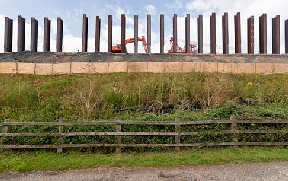
Minimising the construction footprint and protecting
existing habitat during sheet piling
A population of water voles was also identified in and around the motorway drainage ditches adjacent to the carriageway. Over a period of months the water voles were captured and overwintered in a specialist offsite facility. Working closely with the Essex Wildlife Trust it was agreed that the water voles could make a significant contribution to the ongoing Water Vole Recovery Project on the River Colne in Essex. Following a captive breeding programme the population increased to over 200 voles which were then successfully released into their new habitat.
M25 DBFO Section 6 Hatfield Tunnel Refurbishment (CQA170G)
Whole Project Award – Excellent (75.5%)
The project comprised the upgrade of mechanical and electrical equipment associated with the 1km long motorway tunnel between Junction 3 and 4 of the A1(M).
The design of the new tunnel equipment included features, such as variable lighting levels to smooth the transition between conditions inside and outside the tunnel, reducing driver stress, as well as energy consumption.
An extensive community relations programme was implemented as part
of the scheme. This involved public exhibitions at key stages of the
project and regular contact with the local community by the dedicated
Community Relations Manager; the project achieved a Silver Considerate
Constructors Scheme Award.

